Rome Part III - Il Foro Romano
On Sunday afternoon I visited the Roman Forum. It is a little confusing - it is in fact free to look through these ruins. It is located just next to the Colosseum, and also shares a border with the Palatine Hill, which is what I had bought a combined ticket for in the morning. I wanted some sort of guide for the Forum, however the next English-speaking tour was not until 6pm. I then had the idea to get one of those audio guides I had seen many people use in the Vatican and Pompeii in 2004. So I approached the little green hut at the north entrance where two staff members were located. Honestly, they looked so lazy. I don't think they did anything except tell people who came in the north entrance seeking information to go down the path and turn left. So, that's what I did. I went down until I came to a T-junction, and turned left. On the corner is this building. It's the Temple of Antoninus and Faustina, which is one of the best preserved of the ruins.
 I looked around all over the place and finally found the booth on the south side of the forum. I purchased the guide for a few Euros. It's like you're talking on one of those chunky satellite phones. There were two mini-tours. I started on the second of them, as it began very close by. It basically followed the Via Sacra, or Sacred Way. The first stop was the Arch of Titus.
I looked around all over the place and finally found the booth on the south side of the forum. I purchased the guide for a few Euros. It's like you're talking on one of those chunky satellite phones. There were two mini-tours. I started on the second of them, as it began very close by. It basically followed the Via Sacra, or Sacred Way. The first stop was the Arch of Titus. It is the highest point in the Forum. Here is a close-up of the inscription on the arch.
It is the highest point in the Forum. Here is a close-up of the inscription on the arch. Following the path westward, here is a view of part of the Palatine Hill, looking south.
Following the path westward, here is a view of part of the Palatine Hill, looking south.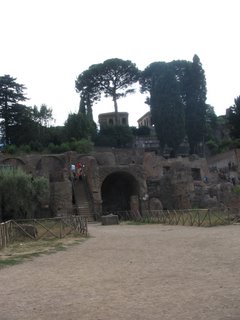 Also along the path is the Basilica of Constantine. Unfortunately, less than one third of it still remains. It's mainly just an open-air stone pile.
Also along the path is the Basilica of Constantine. Unfortunately, less than one third of it still remains. It's mainly just an open-air stone pile.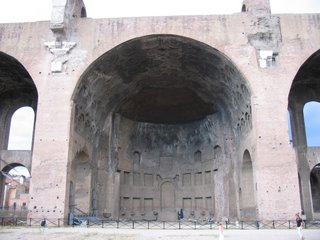 The next stop on the tour was the Temple of Romulus. However, now it is the church of Saints Cosma and Damiano, which you might recognise from band religious processions.
The next stop on the tour was the Temple of Romulus. However, now it is the church of Saints Cosma and Damiano, which you might recognise from band religious processions.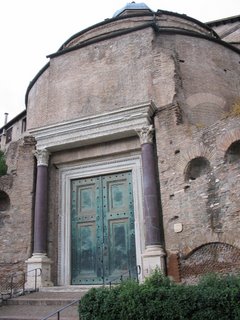 The three pillars (near the Temple of Vesta) in this photo are all that remains of the Temple of Castor and Pollux. These were the legendary warrior twins which are now part of the Gemini constellation.
The three pillars (near the Temple of Vesta) in this photo are all that remains of the Temple of Castor and Pollux. These were the legendary warrior twins which are now part of the Gemini constellation.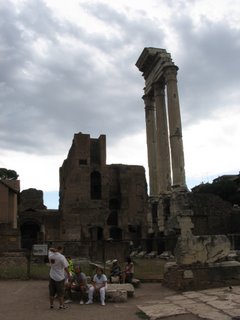 I then switched to the other tour on the audio guide. This photo was taken somewhere around the temple of Julius Caesar, looking west towards the Tabularium. The triple arch towards the right is the Arch of Semptimius Severus.
I then switched to the other tour on the audio guide. This photo was taken somewhere around the temple of Julius Caesar, looking west towards the Tabularium. The triple arch towards the right is the Arch of Semptimius Severus. This photo was taken just in front of the Arch of Septimius Severus looking southeast along the Via Sacra, in other words the opposite direction to the previous photo. Some trees on the Palatine Hill are visible in the distance on the right.
This photo was taken just in front of the Arch of Septimius Severus looking southeast along the Via Sacra, in other words the opposite direction to the previous photo. Some trees on the Palatine Hill are visible in the distance on the right.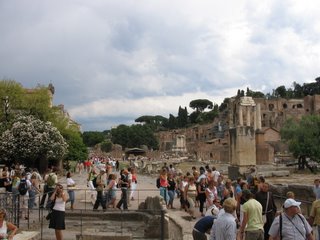 Here is the Arch of Septimius Severus itself, constructed by the emperor Septimius in honour of his two sons. The notable point here is that one of his sons killed the other then removed his name from the inscription at the top of the arch.
Here is the Arch of Septimius Severus itself, constructed by the emperor Septimius in honour of his two sons. The notable point here is that one of his sons killed the other then removed his name from the inscription at the top of the arch.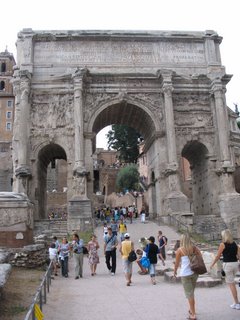 Finally, these columns are from the ruins of the Temple of Saturn. Saturn is the god of agriculture, and offerings to him were made here. December also used to include a week called Saturnalia, when many of the rules and regulations were not quite as strict and roles of master and slaves were reversed - makes it sound like Ancient Roman Big Brother.
Finally, these columns are from the ruins of the Temple of Saturn. Saturn is the god of agriculture, and offerings to him were made here. December also used to include a week called Saturnalia, when many of the rules and regulations were not quite as strict and roles of master and slaves were reversed - makes it sound like Ancient Roman Big Brother.
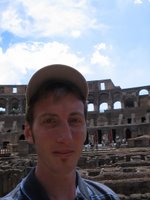

<< Home